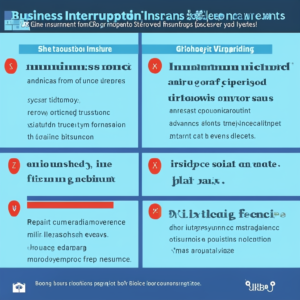Introduction
In an increasingly interconnected global economy, supply chains are the backbone of many businesses, facilitating the flow of goods and services from suppliers to consumers. However, with this interconnectedness comes a host of third-party risks that can disrupt operations and lead to significant financial losses. From supplier insolvencies to natural disasters and cybersecurity threats, the potential for disruption is ever-present. This is where supply chain insurance comes into play, offering businesses a vital safety net against these risks. In this blog post, we will explore the various aspects of supply chain insurance, highlighting how it can protect your business from third-party risks and ensure continuity in the face of uncertainty.
Understanding Supply Chain Risks
Definition of Supply Chain Risks
Supply chain risks refer to potential disruptions or vulnerabilities that can impact the flow of goods, services, and information throughout the supply chain. These risks can arise from various sources, including internal processes, external factors, and third-party relationships. Understanding supply chain risks is crucial for businesses, as they can significantly affect operational efficiency, financial performance, and overall competitiveness.
Supply chain risks can manifest in numerous ways, such as delays in production, increased costs, and compromised product quality. They can also lead to reputational damage if customers experience service interruptions or product shortages. As global supply chains become increasingly complex and interconnected, the potential for risks to escalate and create widespread disruptions has grown. Therefore, businesses must proactively identify, assess, and mitigate these risks to ensure resilience and continuity in their operations.
Effective risk management strategies involve a comprehensive understanding of the supply chain landscape, including the identification of key stakeholders, processes, and potential vulnerabilities. By implementing robust risk assessment frameworks and contingency plans, organizations can better navigate uncertainties and maintain a competitive edge in the marketplace.
Types of Third-Party Risks
Third-party risks are a significant component of supply chain risks, as they involve external entities that play a crucial role in the supply chain ecosystem. Understanding the various types of third-party risks is essential for businesses to develop effective risk management strategies.
Supplier Insolvency
Supplier insolvency occurs when a supplier is unable to meet its financial obligations, leading to potential disruptions in the supply chain. This risk can arise from various factors, including poor financial management, market fluctuations, or unexpected operational challenges. When a key supplier faces insolvency, it can result in delays in production, increased costs, and a need to find alternative suppliers on short notice. To mitigate this risk, businesses should conduct thorough financial assessments of their suppliers, establish strong relationships, and diversify their supplier base to reduce dependency on a single source.
Natural Disasters
Natural disasters, such as hurricanes, earthquakes, floods, and wildfires, can have devastating effects on supply chains. These events can disrupt transportation routes, damage facilities, and halt production processes. The unpredictability of natural disasters makes them a significant risk factor for businesses operating in vulnerable regions. To prepare for such events, companies should develop disaster recovery plans, invest in resilient infrastructure, and establish contingency measures to ensure continuity of operations in the face of natural disasters.
Transportation Disruptions
Transportation disruptions can occur due to various factors, including traffic congestion, port closures, labor strikes, and regulatory changes. These disruptions can lead to delays in the delivery of goods, increased shipping costs, and potential stockouts. Businesses must closely monitor transportation networks and establish strong relationships with logistics providers to mitigate the impact of transportation disruptions. Implementing real-time tracking systems and alternative routing options can also enhance supply chain resilience in the face of transportation challenges.
Cybersecurity Threats
In an increasingly digital world, cybersecurity threats pose a significant risk to supply chains. Cyberattacks can target sensitive data, disrupt operations, and compromise the integrity of supply chain processes. A successful cyberattack on a supplier or logistics provider can have a cascading effect on the entire supply chain, leading to data breaches, operational downtime, and reputational damage. To mitigate cybersecurity risks, businesses should implement robust cybersecurity measures, conduct regular assessments, and ensure that third-party partners adhere to stringent security protocols.
The Ripple Effect of Supply Chain Disruptions on Business Operations
The ripple effect of supply chain disruptions can have far-reaching consequences for businesses, impacting various aspects of operations, financial performance, and customer satisfaction. When a disruption occurs, it can create a chain reaction that affects not only the immediate parties involved but also the entire supply chain ecosystem.
One of the most immediate impacts of supply chain disruptions is the delay in product availability. When suppliers face challenges, it can lead to stockouts, backorders, and delays in fulfilling customer orders. This not only affects revenue but can also damage customer relationships and brand reputation. Customers expect timely delivery and consistent product availability, and any disruption can lead to dissatisfaction and loss of trust.
Supply chain disruptions can result in increased operational costs. Businesses may need to expedite shipping, source alternative suppliers at higher prices, or invest in additional inventory to mitigate the impact of disruptions. These increased costs can erode profit margins and negatively affect overall financial performance.
The ripple effect can extend to employee morale and productivity. When disruptions occur, employees may face increased workloads, stress, and uncertainty. This can lead to decreased job satisfaction and higher turnover rates, further complicating the recovery process.
Understanding supply chain risks is essential for businesses to navigate the complexities of modern supply chains. By identifying and mitigating third-party risks, organizations can enhance their resilience and minimize the ripple effects of disruptions on their operations. Implementing proactive risk management strategies is crucial for maintaining competitiveness and ensuring long-term success in an ever-evolving marketplace.
The Importance of Supply Chain Insurance
What is Supply Chain Insurance?
Supply chain insurance is a specialized form of insurance designed to protect businesses from financial losses resulting from disruptions in their supply chain. These disruptions can arise from various factors, including natural disasters, supplier insolvency, transportation issues, and geopolitical events. Supply chain insurance provides coverage for a range of risks, ensuring that businesses can recover quickly and maintain operational continuity in the face of unforeseen challenges.
This type of insurance typically covers losses related to business interruption, extra expenses incurred to mitigate disruptions, and potential revenue losses due to supply chain failures. By investing in supply chain insurance, companies can safeguard their financial health and ensure that they are prepared to navigate the complexities of modern supply chains. As global supply chains become increasingly interconnected and vulnerable to various risks, the importance of having a robust supply chain insurance policy cannot be overstated.
Key Benefits of Having Supply Chain Insurance
Having supply chain insurance offers several key benefits that can significantly enhance a company’s resilience and operational efficiency. Understanding these benefits is crucial for businesses looking to protect themselves against potential disruptions.
Financial Protection Against Losses
One of the primary benefits of supply chain insurance is the financial protection it provides against losses incurred due to supply chain disruptions. When a disruption occurs, businesses can face significant costs, including lost revenue, increased operational expenses, and potential penalties for failing to meet contractual obligations. Supply chain insurance helps mitigate these financial risks by covering the costs associated with business interruptions, allowing companies to recover more quickly and maintain their financial stability.
For example, if a natural disaster damages a supplier’s facility, leading to production delays, supply chain insurance can cover the lost income and additional expenses incurred while sourcing alternative suppliers or expediting shipments. This financial safety net enables businesses to focus on recovery and continuity rather than worrying about the immediate financial impact of disruptions.
Enhanced Business Continuity Planning
Supply chain insurance plays a vital role in enhancing business continuity planning. By identifying potential risks and understanding the coverage options available, companies can develop more effective contingency plans to address supply chain disruptions. Insurance providers often offer risk assessment services, helping businesses identify vulnerabilities within their supply chains and implement strategies to mitigate those risks.
With a comprehensive supply chain insurance policy in place, businesses can ensure that they have the necessary resources to respond to disruptions swiftly. This proactive approach to risk management not only minimizes downtime but also enhances overall operational resilience. Companies that prioritize business continuity planning are better equipped to navigate challenges and maintain customer satisfaction, even in the face of adversity.
Improved Supplier Relationships
Having supply chain insurance can also lead to improved relationships with suppliers. When businesses invest in insurance coverage, they demonstrate a commitment to managing risks effectively, which can foster trust and collaboration with suppliers. Suppliers are more likely to view companies with robust risk management practices as reliable partners, leading to stronger relationships and better communication.
Supply chain insurance can provide suppliers with confidence that their customers are prepared to handle disruptions. This can lead to more favorable terms, such as extended payment periods or priority access to resources during times of crisis. By strengthening supplier relationships, businesses can create a more resilient supply chain that is better equipped to withstand disruptions.
Regulatory and Compliance Considerations
When it comes to supply chain insurance, regulatory and compliance considerations are essential for businesses to understand. Various industries are subject to specific regulations that may require companies to maintain certain levels of insurance coverage. For instance, companies in the manufacturing, transportation, and food industries often face stringent regulatory requirements related to supply chain management and risk mitigation.
Compliance with these regulations is crucial not only for avoiding penalties but also for maintaining a positive reputation in the marketplace. Insurance providers can assist businesses in navigating the complex landscape of regulatory requirements, ensuring that they have the appropriate coverage in place to meet compliance standards.
Having supply chain insurance can enhance a company’s credibility with stakeholders, including investors, customers, and regulatory bodies. Demonstrating a commitment to risk management and compliance can improve a company’s standing in the eyes of these stakeholders, potentially leading to increased business opportunities and partnerships.
Supply chain insurance is a vital tool for businesses looking to protect themselves against the myriad risks associated with supply chain disruptions. By understanding the importance of supply chain insurance and its key benefits, companies can enhance their resilience, improve supplier relationships, and ensure compliance with regulatory requirements. Investing in supply chain insurance is not just a safeguard against potential losses; it is a strategic decision that can contribute to long-term success in an increasingly complex and interconnected business environment.
Assessing Your Supply Chain Risks
Conducting a Risk Assessment
Conducting a thorough risk assessment is a fundamental step in understanding and managing supply chain risks. This process involves identifying potential threats to the supply chain and evaluating the vulnerabilities that could impact business operations. A well-executed risk assessment enables organizations to proactively address risks and develop strategies to mitigate their effects.
Identifying Critical Suppliers and Partners
The first step in conducting a risk assessment is to identify critical suppliers and partners within the supply chain. These are the entities that play a vital role in the production and delivery of goods and services. Understanding which suppliers are essential to your operations allows you to focus your risk assessment efforts on those relationships that could have the most significant impact on your business.
To identify critical suppliers, businesses should consider factors such as the volume of goods supplied, the uniqueness of the products or services provided, and the potential consequences of a disruption in supply. Engaging in open communication with suppliers can also provide insights into their operational stability and any challenges they may be facing. By mapping out the supply chain and pinpointing critical suppliers, organizations can prioritize their risk management efforts and allocate resources effectively.
Evaluating Potential Vulnerabilities
Once critical suppliers and partners have been identified, the next step is to evaluate potential vulnerabilities within the supply chain. This involves analyzing various factors that could lead to disruptions, such as financial instability, geopolitical risks, natural disasters, and operational inefficiencies.
Businesses should assess the geographic locations of their suppliers, as certain regions may be more prone to natural disasters or political instability. Additionally, evaluating the financial health of suppliers is crucial; companies can conduct credit checks, review financial statements, and monitor industry trends to gauge the stability of their partners.
Organizations should consider the technological aspects of their supply chain. Cybersecurity vulnerabilities can pose significant risks, especially as supply chains become increasingly digital. Conducting audits of suppliers’ cybersecurity measures and ensuring compliance with industry standards can help mitigate these risks.
By thoroughly evaluating potential vulnerabilities, businesses can gain a comprehensive understanding of the risks they face and develop targeted strategies to address them.
Developing a Risk Management Strategy
After conducting a risk assessment, the next step is to develop a robust risk management strategy. This strategy should outline the steps that will be taken to mitigate identified risks and ensure business continuity in the event of a disruption.
Diversifying Suppliers
One of the most effective ways to manage supply chain risks is to diversify suppliers. Relying on a single supplier for critical components or services can create significant vulnerabilities. By establishing relationships with multiple suppliers, businesses can reduce their dependency on any one source and create a more resilient supply chain.
Diversification can take various forms, including sourcing from suppliers in different geographic regions, engaging with suppliers of varying sizes, and exploring alternative materials or components. This approach not only mitigates risks associated with supplier insolvency or disruptions but also fosters healthy competition among suppliers, potentially leading to better pricing and service levels.
Businesses should regularly review their supplier base to identify opportunities for diversification. Engaging in supplier audits and performance evaluations can help organizations identify potential weaknesses in their supply chain and make informed decisions about expanding their supplier network.
Establishing Contingency Plans
Establishing contingency plans is another critical component of a comprehensive risk management strategy. Contingency plans outline the steps that will be taken in the event of a supply chain disruption, ensuring that businesses can respond quickly and effectively to minimize the impact on operations.
These plans should include clear protocols for communication, resource allocation, and decision-making during a crisis. For example, businesses may develop procedures for quickly sourcing alternative suppliers, reallocating inventory, or adjusting production schedules in response to disruptions.
Regularly testing and updating contingency plans is essential to ensure their effectiveness. Conducting simulation exercises or tabletop drills can help organizations identify gaps in their plans and refine their response strategies. Additionally, maintaining open lines of communication with suppliers and partners is crucial for ensuring that everyone is aligned and prepared to respond to potential disruptions.
Assessing supply chain risks is a vital process that involves conducting thorough risk assessments and developing effective risk management strategies. By identifying critical suppliers, evaluating vulnerabilities, diversifying suppliers, and establishing contingency plans, organizations can enhance their resilience and ensure business continuity in the face of potential disruptions. Proactive risk management not only protects businesses from financial losses but also strengthens relationships with suppliers and fosters a culture of preparedness within the organization.
FAQs
Q: What is supply chain insurance?
A: Supply chain insurance protects businesses from financial losses caused by disruptions in their supply chain, such as delays, damages, or failures from third-party suppliers.
Q: What types of risks does supply chain insurance cover?
A: It covers risks like natural disasters, supplier bankruptcy, transportation issues, and political instability that can affect the supply chain.
Q: Why is supply chain insurance important for businesses?
A: It helps businesses mitigate financial losses, maintain operations, and ensure they can meet customer demands even when unexpected disruptions occur.
Q: How can I determine if my business needs supply chain insurance?
A: If your business relies heavily on third-party suppliers or has complex supply chains, it’s wise to consider this insurance to protect against potential risks.
Q: What factors affect the cost of supply chain insurance?
A: Costs can vary based on the size of the business, the complexity of the supply chain, the types of coverage needed, and the specific risks involved.
Q: How can I choose the right supply chain insurance policy?
A: Assess your business’s unique risks, consult with an insurance expert, and compare different policies to find coverage that best fits your needs and budget.
Conclusion
In conclusion, supply chain insurance is an essential component of a comprehensive risk management strategy for businesses operating in today’s complex environment. By understanding the various types of third-party risks and the protective measures that supply chain insurance offers, companies can safeguard their operations and financial health. Proactively assessing vulnerabilities and investing in tailored insurance coverage not only mitigates potential losses but also enhances resilience in the face of unforeseen challenges. As businesses navigate the intricacies of their supply chains, the importance of effective risk management through supply chain insurance cannot be overstated. Investing in this protection today can lead to a more secure and sustainable future for your business.




